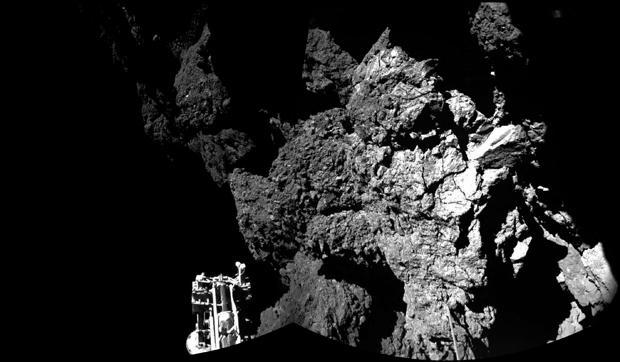Lost Rosetta comet lander finally found
The European Space Agency’s Rosetta spacecraft, flying in formation with comet 67P/Churyumov-Gerasimenko, has finally found its lost Philae lander, which bounced off the low-gravity comet during a landing attempt in 2014 and ended up on its side in a jumble of rocks, its location unknown and its battery quickly dying,
Project engineers have been searching for Philae ever since and last Friday, Rosetta’s high-resolution camera finally spotted the ill-fated lander resting in a chaotic pile of shadowed rocks, its body wedged between boulders and one landing leg extending upward. Rosetta was just 1.7 miles above the comet when the images were captured.
Even so, Philae is difficult to make out, clearly showing why the lander’s solar arrays were unable to re-charge its batteries and why the spacecraft was so difficult to find.
The discovery came just one month before Rosetta’s trail-blazing mission comes to an end with a long-planned terminal descent to the surface Sept. 30. As 67P/Churyumov-Gerasimenko heads away from the sun, Rosetta can no longer collect enough solar power to continue normal operations.
“With only a month left of the Rosetta mission, we are so happy to have finally imaged Philae, and to see it in such amazing detail,” Cecilia Tubiana of the OSIRIS camera team said in an ESA statement. She was the first person to see the images after they were downlinked Sunday.
Philae was released from Rosetta on Nov. 12, 2014. Based on a later analysis, the lander bounced off the surface, bounced again an unknown distance away and ended up, two hours later, on its side in what its camera showed was a heavily shadowed, extremely rocky area near what appeared to be the side of a cliff.
The lander’s batteries died three days later and the spacecraft went into hibernation. Mission managers hoped that as the comet neared the sun, enough sunlight might reach its solar arrays to wake it up. And in June and July 2015, Philae did, in fact, briefly attempt to communicate.
While no science data were received, engineers were able to narrow down the lander’s location to a relatively small area but were unable to spot the spacecraft. Until now.
“This remarkable discovery comes at the end of a long, painstaking search,” Patrick Martin, ESA’s Rosetta mission manager, said in the ESA release. “We were beginning to think that Philae would remain lost forever. It is incredible we have captured this at the final hour.”
Matt Taylor, Rosetta’s project scientist, said the discovery would allow scientists to “put Philae’s three days of science into proper context.”
